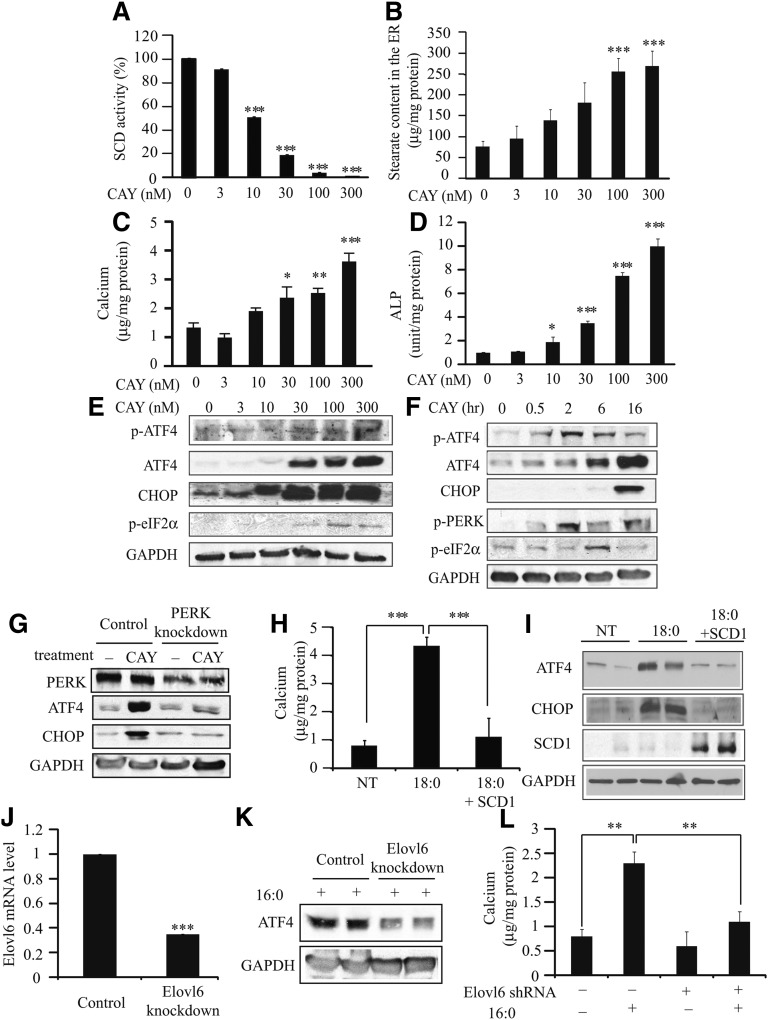
| Size | Price | Stock | Qty |
|---|---|---|---|
| 5mg |
|
||
| 10mg |
|
||
| 25mg |
|
||
| 50mg |
|
||
| 1g |
|
Purity: ≥98%
CAY10566 is a novel, orally bioavailable and selective SCD1 (stearoyl-CoA desaturase 1) inhibitor with IC50 values of 4.5 and 26 nM in mouse and human enzymatic assays, respectively. Cancer cell growth requires fatty acids to replicate cellular membranes. The kinase Akt is known to up-regulate fatty acid synthesis and desaturation, which is carried out by the oxygen-consuming enzyme stearoyl-CoA desaturase (SCD)1.
| ln Vitro |
Swiss 3T3 cell proliferation is concentration-dependently inhibited by CAY10566 (0.0001-10 μM; 24 hours) [3].
|
|---|---|
| ln Vivo |
Once the tumors became stable, the mice were given either vehicle or SCD1 complementation (2.5 mg/kg CAY10566, administered at least twice a day). SCD1 inhibition was more effective in suppressing Akt-driven tumors than Ras-driven tumors; mean tumor volumes on day 13 or 14 post-treatment were 0.5 ± 0.04 and 0.67 ± 0.05, respectively, compared with untreated tumors (P=0.01 Compared with Ras-Akt, passed two-tailed t test)[4].
|
| Cell Assay |
Cell Proliferation Assay[3]
Cell Types: Swiss 3T3 cells Tested Concentrations: 0.0001, 0.001, 0.01, 0.1, 1, 10 μM Incubation Duration: 24 hrs (hours) Experimental Results: Swiss 3T3 cell proliferation diminished in a concentration-dependent manner. |
| References |
|
| Molecular Formula |
C18H17CLFN5O2
|
|---|---|
| Molecular Weight |
389.8113
|
| Exact Mass |
389.105
|
| Elemental Analysis |
C, 55.46; H, 4.40; Cl, 9.09; F, 4.87; N, 17.97; O, 8.21
|
| CAS # |
944808-88-2
|
| PubChem CID |
16732433
|
| Appearance |
Off-white to yellow solid powder
|
| Density |
1.4±0.1 g/cm3
|
| Boiling Point |
600.2±65.0 °C at 760 mmHg
|
| Flash Point |
316.8±34.3 °C
|
| Vapour Pressure |
0.0±1.7 mmHg at 25°C
|
| Index of Refraction |
1.592
|
| LogP |
1.88
|
| Hydrogen Bond Donor Count |
0
|
| Hydrogen Bond Acceptor Count |
8
|
| Rotatable Bond Count |
4
|
| Heavy Atom Count |
27
|
| Complexity |
485
|
| Defined Atom Stereocenter Count |
0
|
| SMILES |
FC1C=C(OC2CCN(C3C=CC(C4OC(C)=NN=4)=NN=3)CC2)C(Cl)=CC=1
|
| InChi Key |
WFOFPVXMPTVOTJ-UHFFFAOYSA-N
|
| InChi Code |
InChI=1S/C18H17ClFN5O2/c1-11-21-24-18(26-11)15-4-5-17(23-22-15)25-8-6-13(7-9-25)27-16-10-12(20)2-3-14(16)19/h2-5,10,13H,6-9H2,1H3
|
| Chemical Name |
3-[4-(2-chloro-5-fluorophenoxy)-1-piperidinyl]-6-(5-methyl-1,3,4-oxadiazol-2-yl)-pyridazine
|
| Synonyms |
CAY10566; CAY-10566; CAY 10566
|
| HS Tariff Code |
2934.99.03.00
|
| Storage |
Powder -20°C 3 years 4°C 2 years In solvent -80°C 6 months -20°C 1 month |
| Shipping Condition |
Room temperature (This product is stable at ambient temperature for a few days during ordinary shipping and time spent in Customs)
|
| Solubility (In Vitro) |
DMSO : ~25 mg/mL (~64.13 mM)
|
|---|---|
| Solubility (In Vivo) |
Solubility in Formulation 1: ≥ 2.5 mg/mL (6.41 mM) (saturation unknown) in 10% DMSO + 90% (20% SBE-β-CD in Saline) (add these co-solvents sequentially from left to right, and one by one), clear solution.
For example, if 1 mL of working solution is to be prepared, you can add 100 μL of 25.0 mg/mL clear DMSO stock solution to 900 μL of 20% SBE-β-CD physiological saline solution and mix evenly. Preparation of 20% SBE-β-CD in Saline (4°C,1 week): Dissolve 2 g SBE-β-CD in 10 mL saline to obtain a clear solution. Solubility in Formulation 2: ≥ 2.5 mg/mL (6.41 mM) (saturation unknown) in 10% DMSO + 90% Corn Oil (add these co-solvents sequentially from left to right, and one by one), clear solution. For example, if 1 mL of working solution is to be prepared, you can add 100 μL of 25.0 mg/mL clear DMSO stock solution to 900 μL of corn oil and mix evenly. View More
Solubility in Formulation 3: ≥ 2.08 mg/mL (5.34 mM) (saturation unknown) in 10% DMSO + 40% PEG300 + 5% Tween80 + 45% Saline (add these co-solvents sequentially from left to right, and one by one), clear solution. |
| Preparing Stock Solutions | 1 mg | 5 mg | 10 mg | |
| 1 mM | 2.5654 mL | 12.8268 mL | 25.6535 mL | |
| 5 mM | 0.5131 mL | 2.5654 mL | 5.1307 mL | |
| 10 mM | 0.2565 mL | 1.2827 mL | 2.5654 mL |
*Note: Please select an appropriate solvent for the preparation of stock solution based on your experiment needs. For most products, DMSO can be used for preparing stock solutions (e.g. 5 mM, 10 mM, or 20 mM concentration); some products with high aqueous solubility may be dissolved in water directly. Solubility information is available at the above Solubility Data section. Once the stock solution is prepared, aliquot it to routine usage volumes and store at -20°C or -80°C. Avoid repeated freeze and thaw cycles.
Calculation results
Working concentration: mg/mL;
Method for preparing DMSO stock solution: mg drug pre-dissolved in μL DMSO (stock solution concentration mg/mL). Please contact us first if the concentration exceeds the DMSO solubility of the batch of drug.
Method for preparing in vivo formulation::Take μL DMSO stock solution, next add μL PEG300, mix and clarify, next addμL Tween 80, mix and clarify, next add μL ddH2O,mix and clarify.
(1) Please be sure that the solution is clear before the addition of next solvent. Dissolution methods like vortex, ultrasound or warming and heat may be used to aid dissolving.
(2) Be sure to add the solvent(s) in order.
 SCD activity and ER stearate levels regulate ATF4 expression through PERK-eIF2α pathway, mineralization, and osteoblastic differentiation. |
|---|
CD inhibition induces the expression of ER stress and osteogenic markers.J Lipid Res.2012 Aug;53(8):1543-52. |
ATF4 expression alters mineralization and osteoblastic differentiation of VSMCs induced by stearate and SCD inhibitor CAY10566.J Lipid Res.2012 Aug;53(8):15 |